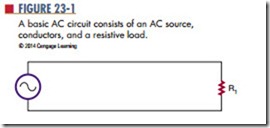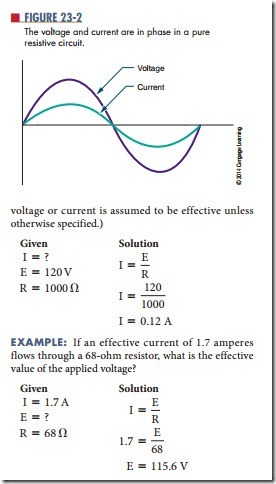Basic ac Resistive circuits
A basic ac circuit (Figure 23-1) consists of an AC source, conductors, and a resistive load. The AC source can be an AC generator or a circuit that generates an AC voltage. The resistive load can be a resistor, a heater, a lamp, or any similar device.
When an AC voltage is applied to the resistive load, the AC current’s amplitude and direction vary in the same manner as those of the applied voltage. When the applied voltage changes polarity, the current also changes. They are said to be in phase. Figure 23-2 shows the in-phase relationship that exists between the current and the applied voltage in a pure resistive circuit. The current and voltage waveforms pass through 0 and maximum values at the same time. However, the two waveforms do not have the same peak amplitudes because they represent different quantities, measured in different units.
The AC current flowing through the resistor varies with the voltage and the resistance in the circuit. The current at any instant can be determined by applying Ohm’s law.
Effective values are used in most measurements.
As stated previously, the effective value is the amount of AC voltage that produces the same degree of heat as a DC voltage of the same value. The effective value can be considered the DC equivalent value. Ohm’s law can be used with effective AC values, just as with DC values, in a pure resistive circuit.
eXaMPLe: If a circuit has an AC voltage source of 120 volts and a resistance of 1000 ohms, what is the effective current in the circuit? (Remember, an AC
Questions
1. What is the phase relationship between current and voltage in a pure resistive circuit?
2. What AC value is used for most measurements?
3. What is the effective current in a circuit of 10,000 V with 12 V applied?
4. What is the voltage (rms) of a circuit with
250 mA flowing through 100 V?
5. What is the resistance of a circuit when 350 mA are produced with an AC voltage of 12 V?

